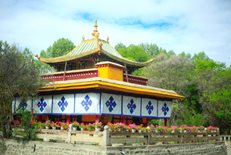
Tibet’s determined capital Lhasa boasts many attractions, but one of the best ways to explore this ancient city is to join in one of its oldest and most venerated rituals: the kora, a devotional circumambulation around Tibet’s premier shrine, the Jokhang. Each day, especially in the early morning and evening, crowds of devout Tibetan Buddhists make their way to the golden-roofed Jokhang Temple to make their obeisances in a ritual that is centuries old.
Situated in the historic center of Lhasa, the Jokhang sprawls over 6.2 acres, containing a warren of chapels, study rooms, and large reception areas. This sacred temple has been the main center of worship of Tibetan Buddhism since the seventh century, and despite political repression by China, remains the most popular pilgrimage destination to this day.
Tibetan Buddhists believe that enlightenment is a journey and a symbol of that journey is to walk in a circle around sacred places: man made or natural. The practice is both meditative and a religious rite which earns pilgrim, or “nekor” (in Tibetan, literally “one who circles around,”) religious merit.
All other koras seem like rehearsals for Lhasa’s Barkhor kora around the sacred Jokhang temple. The faithful come from all over the region to perform this pilgrimage; for many, this is an arduous journey — often on foot — over rough terrain and in the face of government disapproval. Many pilgrims make the final approach and several kora around the Jokhang on their hands and knees, or in a grueling series of full body prostrations: rising from a prone position, to one’s knees, then feet, then back down again. Following the completion of the kora, the faithful make offerings of yak butter or white scarves at one of the 3,000 images and statues of the Buddha inside the ancient Jokhang.
The Barkhor neighborhood surrounding the Jokhang is a fascinating labyrinth of tiny streets and alleyways crammed with small shops and market stalls, selling everything from sacred texts to bowls of noodle soup and local SIM cards. It is a photographer’s dream and a marvelous place to get lost in and soak up the flavor of historic Lhasa, made all the more special with the sad knowledge that this vital neighborhood is under constant threat by the authorities, who proposed a sweeping program of urban renewal in 2013, designed to pull down many of the Barkhor’s oldest buildings.
Join Alexander + Roberts on
Historical China, Tibet + The Yangtze, a remarkable journey for never more than 16 guests.